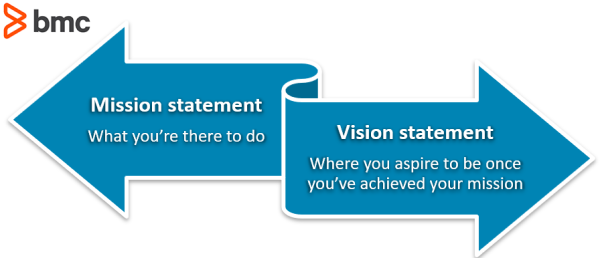Does your service desk have a mission and a vision statement? Does it need one? And probably the most common question I hear, what is the difference between a mission and a vision? Let’s start with that.

What is a mission statement?
A mission statement defines a business’s purpose: what the business is there to do. The mission is normally a a short statement stating why an organization exists, what its overall goal is. The mission will identify the goal of its operations, what kind of product or service it provides, its primary customers or market, and, if appropriate, where it’s base of operations is geographically.
Amazon’s mission statement is a good example of a concise and clear mission:
To serve consumers through online and physical stores and focus on selection, price, and convenience.
What is a vision statement?
The mission statement provides the roadmap for an organization’s vision. The vision statement describes where the organization aspires to be once they have achieved their mission.
Amazon’s vision has a clear link to the mission statement outlined above. Amazon aspires:
To be Earth’s most customer-centric company, where customers can find and discover anything they might want to buy online, and endeavors to offer customers the lowest possible prices.
A cascading mission and vision
Different parts of the same organization will often develop their own mission and vision statements. The development of these statements can be a very valuable exercise, helping to create a clear picture of their purpose and allowing them to create a roadmap leading them towards achieving the vision.
These mission and vision statement cannot be created in isolation. Any internal department must create statements that align to the mission and vision of the organization as a whole. Achievement of a departmental vision must help the organization step closer to attaining their overall vision.
A vision for the service desk
Any vision created by the service desk must underpin the organizational vision. The vision needs to be visible and understood by service desk stakeholders. If this does not happen, the chances of ‘selling’ the service desk vision to the organization are remote.
The vision is a conceptual view of what the future state of the service desk will be, it shows what they are working to achieve. The vision must be presented in clear terms that stakeholders can understand and believe in. Everyone working on the service desk needs to be able to believe in the vision. Those who don’t are unlikely to want to work towards it.
A successful vision statement will come from a team effort, everyone working on the service desk and all key stakeholders should be involved and need to agree on the vision.
While a vision is, by its very nature, aspirational, it must still be achievable, having a vision that will never be realized will be disheartening and counterproductive for the service desk team and is likely to reduce the confidence of its business stakeholders.
The vision needs to build and enhance the image of the service desk in the organization and it will give service desk staff a feeling of pride, it should be concise and easily remembered, and it needs to clearly describe the long term objectives of the service desk.
Creating the mission
A good mission statement will always have two distinct parts:
- A purpose statement. This describes what the service desk is working to achieve.
- The underpinning objectives. These are the business practices that will be required to achieve this purpose.
The mission describes the service desk’s reason for being, it describes what the service desk team is doing, and why it is doing it. When you are writing your mission, consider the who, the what, and the how. Your mission statement needs to outline who you are, what makes you special in the organization, and how you want your service desk to be seen by the rest of the organization.
Just as the vision for the service desk needs to be aligned with the vision of the organization, having a mission that supports that of the wider organization will help unite the service desk with the business at large.
What does a good mission or vision look like?
Let’s see an example what effective vision and mission statements for a service desk might look like. Remember that one size does not fit all, these statements are simply examples of what good statements could be.
Example mission statement
To provide our customers with quality service, focusing on consistent and efficient support through:
- Communication
- Continuous improvement of processes and tools
- Customer engagement
- Professional development
This mission statement gives clear guidance and provides measurable outcomes.
Example vision statement
To be recognized as a single-point-of-contact service desk providing best in class communications and support.
This vision is achievable, it is supported by the mission statement and it is aspirational for service desk staff and stakeholders.
Supporting your goals
Writing these statements is one thing, making them relevant is another. The only way that these statements have any value to the service desk is to measure progress against them.
To do this you will need to decide on your critical success factors (CSFs)—what things do you need to achieve before you can say that you have achieved what you set out to do? Measuring progress towards achieving your CSFs will revolve around key performance indicators (KPIs): each CSF will be supported by a number of KPIs.
What happens when we get there?
Creating your mission and vision statements is not a one-time exercise. They must be regularly reviewed, progress against the objectives needs to be measured, and you need to confirm that the mission and vision for the service desk continues to align with those of the wider organization.
If you have created an achievable vision, it will become out of date once you have reached the goal you have set. This is a time for celebration, but not a time to sit back and think ‘that’s it, we have made it!’ It is then time to reimagine the future state of the service desk and create a new vision that will take you to the next level of service and value provision for your customers.
Additional resources
Head over to these other BMC Blogs for more on service desk culture:
- Service Desk TIPS Explained: Ticket, Incident, Problem, Service Request
- SLA Best Practices for ITIL, Help Desk & Service Desk
- Creating a Strong Service Desk Culture
- Service Desk Best Practices for Creating More Value
These postings are my own and do not necessarily represent BMC's position, strategies, or opinion.
See an error or have a suggestion? Please let us know by emailing [email protected].






